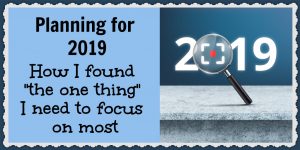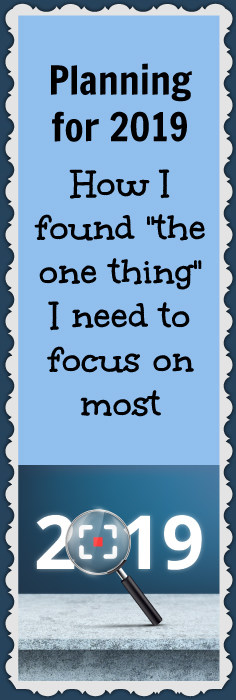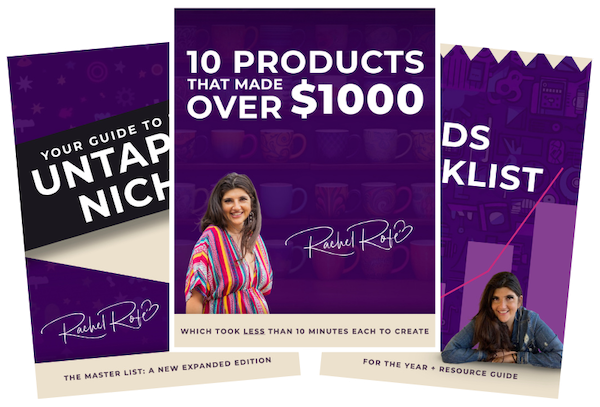Little hinges swing big doors – a friend of mine used to recite this quote, which means big results come from small but powerful actions.
It’s an idea I’ve been focusing on in both my business and personal life. And as I’ve been planning out my 2019, I’ve been more purposeful about how I spend my time and approach my goals.
Planning is essential for long-term success. If you don’t plan, you end up chasing too many rabbits or mindlessly checking items off a to-do list. If you want to achieve great things, having a big-picture goal and a purposeful action plan is a must.
This year I adopted a new planning strategy that I wanted to share with you because it’s helped me a lot. I’ve already been WAY more productive and focused, and I have a much clearer picture of the direction I want to go in.
The strategy involves finding the ONE thing that matters most, the one thing that makes everything else in your business and life easier. It’s getting down to the bare essentials and simplifying.
I know a lot of people are uncomfortable with simplifying. But really, your life becomes so much happier and more successful when you do.
So how does finding “the one thing” work?
“The one thing” is a concept that my mentor really drilled into me. (“The One Thing” is also a book by Gary Keller and Jay Papasan.)
The basic principle behind “the one thing” is to drill down your goals and ideas to find the one thing that matters most—the one thing you need to focus on most to achieve everything else.
You’ve probably heard of the 80/20 principle before. But if not, it basically says that 80% of your results come from 20% of your efforts.
Of course, the breakdown doesn’t have to be exactly 80/20. Just, the bulk of the results you get in your business occurs based on a small number of select actions you take.
So not everything you do matters equally. And that’s what “the one thing” is getting at.
You need to figure out what your “20% “of actions are and then drill down even more to find what matters most and let that drive your day. You need to operate from a clear sense of priority instead of haphazardly running down a to-do list, because being busy is overrated. You want to focus on being productive.
While it may sound difficult to whittle down your goals to just ONE thing, it’s easier than you think. Plus, the benefits are amazing! Finding and sticking to my one thing helps me not have as many items on my to-do list and it just makes everything else flow a whole lot better.
Putting “the one thing” into practice
The one thing can be applied to any area of your life. But to keep things simple, start by separating your life into two parts:
- personal life
- work life
Your personal life consists of multiple areas (e.g. family, friends, community, hobbies, etc.), and all of these areas need to be kept active, although you can still drill down to find one thing that applies to your personal life as well (more on that later on).
When it comes to your work life, though, you have only two areas:
- what matters most
- and everything else
And the way you discover what matters most in your work life is by asking yourself focusing questions.
Focusing questions come in two forms:
- big picture
- small focus
Your big picture question is all about having a vision for your career or business and finding the right direction (what’s your one thing?).
And your small focus question is about finding the right action you should take or what you should be doing presently. It’s what you want to ask yourself first thing in the morning (what’s your one thing right now?).
The answer to your big picture question is your “big one thing,” or your purpose or guiding force. And the answer to your small focus question is your “small one thing,” or the most important action you can take right now (your top priority) to achieve your big one thing.
It’s important to connect productivity, priority, and purpose. Productivity is driven by your purpose (your big one thing) and the number one action you prioritize (your small one thing).
So, in order to be productive and work towards your goals in 2019, you need to figure out what drives you and what your top priority is.
Here’s an example from my life…
Earlier this year, I listed out a few of the top work goals I wanted to achieve in 2019. These included…
- My revenue goals for the warehouse
- My revenue goals for Rachel Rofé Enterprises
- An amount of money I wanted to have in my investment accounts
I also made a list of goals for my personal life as well:
- Feeling at an 8 or above in terms of happiness 90% of the time
- Don and I doing really well
- Having lots of things on my calendar that make me feel alive and happy, such as traveling and seeing friends and family
For my business and money-related goals, I decided that my “one thing” is to concentrate on Rachel Rofe Enterprises.
Here’s why: If I want to grow the warehouse, then I need to hire people to help out at the warehouse. I need to have really good people on the team.
And since my Rachel Rofé Enterprises business has a much greater margin than my warehouse business, I can use the money I earn from that to hire new warehouse people. Plus, that money can also fund my investment accounts.
So concentrating on achieving my revenue goals for Rachel Rofe Enterprises helps me achieve my other important business goals as well, so that’s why it becomes my one thing.
In terms of my personal goals, focusing on planning out my calendar helps me achieve the rest of my goals. For example, one of the ways I can make sure Don and I are doing really well is by spending time together regularly and having date nights. And that’s something I can schedule on my calendar.
Also, traveling and spending time with friends, family, and Don are how I can maintain my happiness levels. And scheduling out this time helps me make sure it actually happens.
Here’s how this works for the Low Hanging System…
One thing I’ve noticed is that a lot of people who do LHS tend to overcomplicate the process. They introduce all these different ideas and try all these different things. And that’s fine if you’ve mastered the basics and want to scale up.
But, especially if you’re just getting started or still getting the hang of things, it’s better to keep it simple.
Normally, I tell people to focus on having great designs with great titles. But if I were to drill down the Low Hanging System into the one most important thing, I would say it’s to make buyer-oriented decisions.
The reason I say that is because if you want to be successful at LHS, the best two things you can do are…
- have a great title – including keywords buyers would use, such as “funny scrapbooking mug” – and
- create buyer-oriented designs – things people are actively searching for, not things you just think would sell well
And to pick the ONE thing here — it would be — make buyer-oriented decisions. When you’re thinking like a buyer, you’re naturally going to do great things with LHS.
Make time for your one thing through time blocking
You want to block off your time for three major areas of your life:
- Time block your time off
- Time block your time to plan
- Time block your one thing
Time off – Take time to plan your time off (i.e. your vacations, weekends, and any other days off you want to have throughout the year). Then, manage your work time around your downtime.
This is how you make sure that all the areas of your personal life remain active and tended to (which I mentioned earlier). Schedule time off to spend with your friends and family and whatever else you enjoy doing so these areas don’t get neglected.
And even though time off may seem counter-productive, it’s essential for your well-being and maintaining your willpower to take action.
Willpower is a finite resource in each of us. So if we want to keep doing our best, we need to take time off to rest and recharge.
Time to plan – This is time to reflect on where you are now and where you want to go. Block off an hour each week to review your annual and monthly goals. And during that time, ask yourself what needs to happen that month for you to be on track with your annual goals. Then, ask what needs to happen that week to be on track with your monthly goals.
Your one thing – Designate a set time to work on your most important priority. If you complete your one thing before the time block is done, refer back to your focus question to figure out how you can best use the time remaining in your time block.
Conversely, if you designate a goal for your one thing and you aren’t finished by the time your time block is over, you should keep working at that goal until it’s done, regardless of the time, whenever possible.
You want to operate on “event time,” not “clock time.” And event time works like this: “I’ll call it a day when it’s done, not when it’s 5:00 PM.”
Protect your time blocks
This is REALLY important. After creating your time blocks, you need to adopt a mindset that they can’t be moved.
If someone tries to double-book you, say something like, “I’m sorry, but I already have an appointment at that time” and offer other options.
Alternatively, if you have trouble saying no, you can say yes but just ask, “If I have it done by such and such a time, would that work?” That way, you’re still honoring the commitments you’ve made to yourself.
Plus, when people ask things of you, they usually don’t need them done immediately. They just want to know they’ll get done eventually.
To get the results you want with your business (and personal life for that matter), time-blocking is really helpful. But in order to make time-blocking effective, you need to make three commitments:
- Adopt the mindset of someone seeking mastery – Basically, you need to commit to being your best and doing the best job you can with what you’re working on.
- Embrace the effort it takes to achieve mastery – Mastering anything takes time and effort. But you need to be purposeful about how you spend your time and direct your efforts, all going back to your one thing.
- Hold yourself accountable for achieving your one thing – Ultimately, you are in charge of whether you achieve your goals. So you need to own the outcomes of your actions and make sure you’re staying on track.
Success Tips
After finding your one thing and creating time blocks, distractions and other obstacles are bound to come up. To help whenever this happens, here are some tips to keep in mind.
Don’t multitask – Multitasking is not an efficient way to get things done, contrary to what many people may think. Starting a new task and then re-starting the task you quit actually costs you time and uses up mental bandwidth. And while you can do two things at once, you can’t focus on two things at once.
Choose the right habits – Choose habits that will bring you success, such as working on your most challenging tasks first and asking yourself every day, “What’s the one thing I can do today to fulfill my purpose and make everything else simpler and easier?” Choose one new habit at a time and give each new habit enough time and discipline to become fully routine. (It takes, on average, 66 days to form a new habit.)
Find a coach – Achieving your goals is SO much easier when you have a support system. It doesn’t have to necessarily be a coach, just someone you can share both your achievements and challenges with, someone who supports and encourages you.
Think big and specific – Imagine your life as big as it can be. Don’t hold back. Don’t fear failure. And don’t choose from only the obvious available options. Adopt a growth mindset and think outside the box. The best goals explore all that is possible.
Key takeaways and action steps:
- Find the one thing that matters most in your business and personal life and let that be your driving force.
- Find the one thing that matters most right now and let that be what you work on at present.
- Create “time blocks” for taking time off, planning, and working on your one most important thing.
- Stay committed to your schedule and the appointments you make to yourself.
- Use the success tips to stick to your time blocks and maintain your focus.
- Create your own plan for 2019 and turn your to-do list into a success list.
What do you think of “the one thing” as a planning strategy for 2019? If you have any suggestions or ideas you want to add, leave a comment below! And if you enjoyed what you read, please share this post.






0 thoughts on “Planning for 2019 – How I found “the one thing” I need to focus on most”
Thanks for sharing, Rachel. The One Thing is not a planning tool I would use for 2019. I would use it… EVERYDAY.
Glad to see you taking the principle and applying it toward LHS.
Most product creators are living in a swathe of confusion and complexity, and this transfers over to all their products and courses. Shedding over their clients and customers and even bigger cloud of confusion. A huge disservice to their client base…
Yeah, good distinction re: using it everyday. I actually do use it on a daily basis as well, and am glad you pointed that out!
Awesome info! Thanks so much for sharing Rachel.
My pleasure – thank you for commenting. :)
Thank you for sharing this Rachel. Some really great tips and a great process for success.
My pleasure – thanks for taking the time to leave a comment. :)
This was this was super helpful! Thanks so much Rachel. Wishing you much success in 2019 :)
Thank you, Tara, and ditto! I hope this year goes amazingly for you. :)